Coasting: California- Carmel to Cabrillo
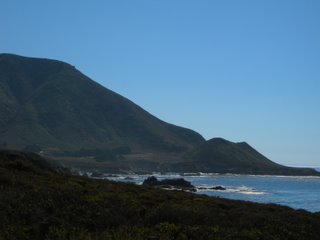
If there is an overused adjective in modern American English, it is “awesome.” This word is close to meaningless because it has become a place filler for an unidentified precise word or, even worse, a mere expletive. In its more vigorous days, awesome meant “eye-popping, breathtaking, wondrous” or “possessing reverential fear or wonder.” All of my hopes through the years that the shameless co-opting of this word to describe pizza or shoes or a haircut would end have been repeatedly dashed and thus, I will strike a small blow against the underthinking and overuse that has coverted “awesome” from blazing cobalt to beige. The California Coast from Carmel south to Santa Barbara is nothing short of AWESOME. Robert Louis Stevenson called this coast “The greatest meeting of land and sea in the world.”
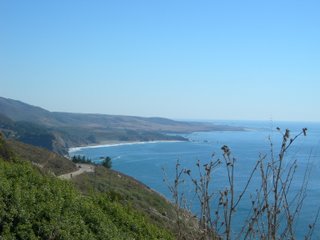 As the road known as “California 1” snakes its way between the crushing crashes of Pacific waves to the right and the jagged rocks and grass covered hills to the left, there is never the slightest doubt that this is a place to rival the most wondrous. Stark and boldly beautiful yet supremely serene and natural, this place hijacks the visitor as even the highway becomes a part of the mysterious effect of the place and the journey. As the road carries you south, through Soberanes Point with its ocean beaches and dense redwood groves and across the mellow yet dramatic heights of Big Sur, the mark of those who have embraced and lived here from the original Chumash or Salina Indians to Henry Miller, Orson Welles, and William Randolph Hearst become figurative outcroppings testifying to the enduring and inspiring power of this great physical landscape. At Big Sur, Welles’ Nepenthe (his gift to Rita Hayworth in the 1940’s) which is now a restaurant hangs over the ocean with a gasp-producing view to accompany the pricey, forgettable food. The Henry Miller Memorial Library
As the road known as “California 1” snakes its way between the crushing crashes of Pacific waves to the right and the jagged rocks and grass covered hills to the left, there is never the slightest doubt that this is a place to rival the most wondrous. Stark and boldly beautiful yet supremely serene and natural, this place hijacks the visitor as even the highway becomes a part of the mysterious effect of the place and the journey. As the road carries you south, through Soberanes Point with its ocean beaches and dense redwood groves and across the mellow yet dramatic heights of Big Sur, the mark of those who have embraced and lived here from the original Chumash or Salina Indians to Henry Miller, Orson Welles, and William Randolph Hearst become figurative outcroppings testifying to the enduring and inspiring power of this great physical landscape. At Big Sur, Welles’ Nepenthe (his gift to Rita Hayworth in the 1940’s) which is now a restaurant hangs over the ocean with a gasp-producing view to accompany the pricey, forgettable food. The Henry Miller Memorial Library 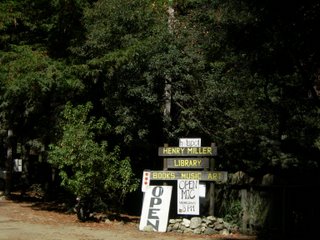 huddles in an evergreen copse ready to serve up its eclectic collection of volumes and artifacts, art and community center- internet access is available- a real anomaly (like eating McDonalds in Rome) in this remote spot where man seems small and the idea of being connected isn’t about Netscape or Verizon. Perhaps the unquenchable quality of our thirst for constant electronic connection has to do with our inability to find a truly “wireless” plug-in with who we are and the greater universe that surrounds us.
huddles in an evergreen copse ready to serve up its eclectic collection of volumes and artifacts, art and community center- internet access is available- a real anomaly (like eating McDonalds in Rome) in this remote spot where man seems small and the idea of being connected isn’t about Netscape or Verizon. Perhaps the unquenchable quality of our thirst for constant electronic connection has to do with our inability to find a truly “wireless” plug-in with who we are and the greater universe that surrounds us. As you head further south past the immense Hearst Castle barely visible to the east in the coastal hills, past the beaches where elephant seals
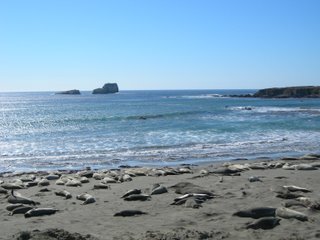 loll away the day flopping from side to side and flipping sand hither and yon to readjust their amazing heft, the majesty of the Ventana Wilderness behind you, you see the monolithic Morro Rock,
loll away the day flopping from side to side and flipping sand hither and yon to readjust their amazing heft, the majesty of the Ventana Wilderness behind you, you see the monolithic Morro Rock, known as the “Gibraltar of the Pacific” jutting dramatically out of the ocean. This has been an extraordinary trek through a part of California which defies the glitz, speed, and sprawl of the notorious urban encampments and serves up a snapshot of our greater selves or at least a mirror to reflect an image of ourselves in a simpler and slower context. As Robinson Jeffers characterized it “this coast crying out for tragedy like all beautiful places.”
known as the “Gibraltar of the Pacific” jutting dramatically out of the ocean. This has been an extraordinary trek through a part of California which defies the glitz, speed, and sprawl of the notorious urban encampments and serves up a snapshot of our greater selves or at least a mirror to reflect an image of ourselves in a simpler and slower context. As Robinson Jeffers characterized it “this coast crying out for tragedy like all beautiful places.”So it is time for Solvang.
 This town was designed to be a real Danish enclave by its Danish founders in 1911 to preserve and continue Danish language and culture, however, it has become an attractive but over-the-top, Disneyfied version of Copenhagen and Denmark. In an odd way, Solvang is more Danish than Denmark. Its need to emphasize and reinvent the place makes it more important to reproduce the most obvious and popular aspects of the Danes. If you’re looking for smorgasbord or Danish pastry or kirsch, then you will be well-rewarded by a visit to Solvang. While it is kitschy, it is fun with its gingerbread-trimmed hotels and shops and fabulous windmills. As the largest town in the Santa Ynez Valley, it also offers great weather and wine, and, of course, this is the location of the Reagan Ranch where our 40th President escaped the stress of politics and government for his final years. While distant in political philosophy, our paths seems to continue to cross during this trip,
This town was designed to be a real Danish enclave by its Danish founders in 1911 to preserve and continue Danish language and culture, however, it has become an attractive but over-the-top, Disneyfied version of Copenhagen and Denmark. In an odd way, Solvang is more Danish than Denmark. Its need to emphasize and reinvent the place makes it more important to reproduce the most obvious and popular aspects of the Danes. If you’re looking for smorgasbord or Danish pastry or kirsch, then you will be well-rewarded by a visit to Solvang. While it is kitschy, it is fun with its gingerbread-trimmed hotels and shops and fabulous windmills. As the largest town in the Santa Ynez Valley, it also offers great weather and wine, and, of course, this is the location of the Reagan Ranch where our 40th President escaped the stress of politics and government for his final years. While distant in political philosophy, our paths seems to continue to cross during this trip, From Santa Barbara, it is a short trip to the burgeoning, ever expanding footprint of Los Angeles. From Ventura on, jutting southeastward now, down the California 101, there is unbroken city, except for the occasional protected or too-expensive-to-develop mountain. When I entered LA, I couldn’t help but notice the amazing contrast of sweeping suburban expansion versus the calm primordial redwood forests just up the coast. It did not take long to be engulfed in the parking lots known as freeways in LA. I soon decided to abandon the clogged arteries of the megalopolis and hit the city streets in my search for Frank Lloyd Wright’s Hollyhock House
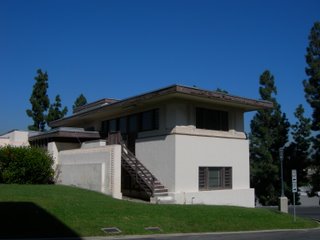 which sits atop Barnsdall Park in the center of old Hollywood. This small park, named for its benefactor, is an arts park. It features not just the first and some say the best example of Wright’s architecture in LA, but public galleries and one of the best views of Hollywood (and the sign) to be had. This house was built in 1921 to resemble a Mayan temple. Aline Barnsdall required that Wright use images of her favorite flower, the hollyhock, throughout the house. Images of hollyhocks in concrete adorn the outside of the building and add to the overall effect of the house as it sits, not at the top, but at the brow of the hill. How Wrightean!
which sits atop Barnsdall Park in the center of old Hollywood. This small park, named for its benefactor, is an arts park. It features not just the first and some say the best example of Wright’s architecture in LA, but public galleries and one of the best views of Hollywood (and the sign) to be had. This house was built in 1921 to resemble a Mayan temple. Aline Barnsdall required that Wright use images of her favorite flower, the hollyhock, throughout the house. Images of hollyhocks in concrete adorn the outside of the building and add to the overall effect of the house as it sits, not at the top, but at the brow of the hill. How Wrightean! Alas on to San Diego,
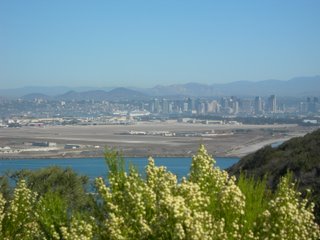 the birthplace of California and the home of the avocado. No wonder I like it so much. With a natural harbor and perfect weather,
the birthplace of California and the home of the avocado. No wonder I like it so much. With a natural harbor and perfect weather,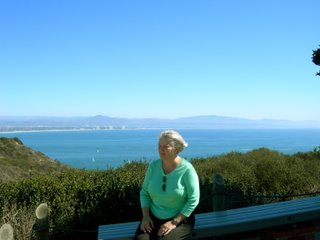 this seems an appropriate spot to launch a trip back across the continent. Visiting Cabrillo National Monument with its sweeping view of San Diego, the harbor, and the Pacific is always restorative and soul satisfying. With the elegant simplicity of Point Loma Lighthouse crowning the peninsula, Cabrillo is dramatic and windswept, a place for walking and whale watching and reverie. There is time left for lunch at our favorite Latin American restaurant, Berta's in Old Town, and we are ready to head east.
this seems an appropriate spot to launch a trip back across the continent. Visiting Cabrillo National Monument with its sweeping view of San Diego, the harbor, and the Pacific is always restorative and soul satisfying. With the elegant simplicity of Point Loma Lighthouse crowning the peninsula, Cabrillo is dramatic and windswept, a place for walking and whale watching and reverie. There is time left for lunch at our favorite Latin American restaurant, Berta's in Old Town, and we are ready to head east. Now up and over to the desert and back to the land of green and trees and…
Now up and over to the desert and back to the land of green and trees and…

0 Comments:
Post a Comment
<< Home